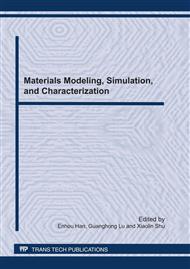p.239
p.245
p.255
p.260
p.269
p.276
p.282
p.289
p.296
Cooling Rate Control on Cold Cracking in Welded Thick HSLA Steel Plate
Abstract:
Cold cracking phenomenon is a very significant problem on welding of steel. This phenomenon usually occurs after welding process finishes in more than 24 hours. Crack often takes place in the heat affected zone area. Generally, cold cracking is due to hydrogen diffusion during welding process, residual stress and susceptible microstructure at low temperature (below 150°C). Welding process on thick plate high strength low alloy (HSLA) steel gives a high risk to cold cracking phenomenon. The cooling rate of thick plate during welding may increase the absorbtion of heat compared to thin plate. Controlling cooling rate is the main factor on welding of thick HSLA steel plate. A single v-butt joint on HSLA and S45C by using Gas Metal Arc Welding (GMAW) has been investigated. This investigation was carried out on a 40 mm thick HSLA steel by controlling cooling rate and by using cooling media such as air, blanket and electric heater. The result shows that prevention of cold cracking can be made by controlling cooling time at low temperature (T300 - T100) in order to keep the cooling time larger than the critical cooling time. The use of cooling media with electric heater can prevent the cold cracking at HSLA weldment. Crack can be found on the weldment due to the presence of stress concentration, local variation of hardness and microstructure, which may result in brittle fracture of the crack surface.
Info:
Periodical:
Pages:
269-275
Citation:
Online since:
June 2011
Authors:
Price:
Сopyright:
© 2011 Trans Tech Publications Ltd. All Rights Reserved
Share:
Citation:


